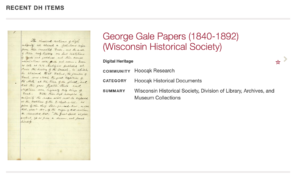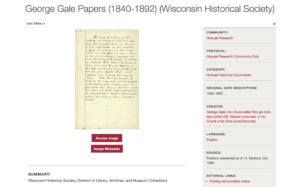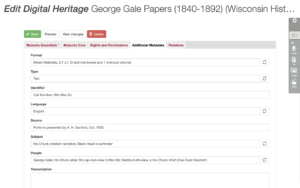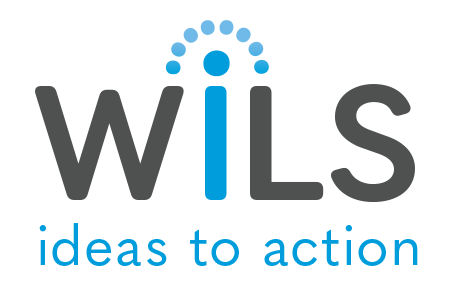This blog post is contributed by Maxwell Gray, a graduate student at the UW-Madison iSchool. Max is one of four practicum and independent study students WiLS is hosting (virtually) from the iSchool this fall. The students are working with Molli Pauliot and Dr. Stephen Kantrowitz of the Department of History at UW-Madison, using Mukurtu CMS to develop an online gateway to Ho-Chunk research materials. Mukurtu was developed by the Center for Digital Scholarship and Curation at Washington State University to empower Indigenous institutions to ethically manage, narrate, and share their digital cultural heritage. WiLS and the iSchool are partners in WSU’s IMLS-funded initiative to provide support and training to Mukurtu users in the Western Great Lakes.
 Established in 2016 by WiLS and the iSchool at the University of Wisconsin—Madison, the Mukurtu Midwest Hub provides support and training in the Mukurtu (“MOOK-oo-too”) content management system managed by the Center for Digital Scholarship and Curation at Washington State University.
Established in 2016 by WiLS and the iSchool at the University of Wisconsin—Madison, the Mukurtu Midwest Hub provides support and training in the Mukurtu (“MOOK-oo-too”) content management system managed by the Center for Digital Scholarship and Curation at Washington State University.
Originally developed by the Center in close collaboration with Indigenous communities in Australia and Washington State, Mukurtu is an open-source CMS designed for the unique, flexible needs of Indigenous libraries, archives, museums, and related cultural heritage institutions and projects. More than just a CMS, the Mukurtu platform and Midwest Hub share a community-driven ethos of collaboration among information professionals and Indigenous communities for the empowerment of Indigenous institutions and projects to ethically manage, narrate and share their digital cultural heritage in community-specific ways, and on their own culturally-relevant terms.
This fall semester, myself and three other graduate students in the master’s program in library and information studies at the iSchool are working with WiLS team members and Ho-Chunk studies scholars and community members to develop a digital bibliography and online gateway for Ho-Chunk studies sources and archives called the Hoocąk Research Gateway, hosted at the Mukurtu Midwest Hub instance of the Mukurtu platform.
 The project will include descriptive metadata for physical and digital Ho-Chunk studies sources and special and archival collections across the country. Users will be able to search the collection of bibliographic citations like an online library catalog to discover Ho-Chunk studies sources and collections, including links to digital objects and collections available online.
The project will include descriptive metadata for physical and digital Ho-Chunk studies sources and special and archival collections across the country. Users will be able to search the collection of bibliographic citations like an online library catalog to discover Ho-Chunk studies sources and collections, including links to digital objects and collections available online.
Our primary goal for the fall semester is developing metadata standards for the project. The Mukurtu platform includes more than 30 pre-established metadata fields, but specific projects on the platform are encouraged to develop their own standards for the metadata fields that are useful for them (and to not use the fields that aren’t useful for them).
For the Hoocąk Research Gateway, we’re developing metadata standards for approximately ninety percent of the platform’s pre-established metadata fields. Many of our metadata standards look similar to the platform metadata standards (v2.1), but we’re revising them to reflect the Ho-Chunk studies sources and collections of the project bibliography.
We’re developing the “Categories” field to organize the collection in five source/collection categories. Our metadata standard (in progress) for the “Categories” field is included below. (“Digital Heritage Items” represent specific Ho-Chunk studies sources or special or archival collections included in the project bibliography.)
Categories are high-level descriptive terms that group Digital Heritage Items together and help users browse and discover them. Each Digital Heritage Item must belong to at least one Category. Check the box beside each relevant Category. The Hoocąk Research Gateway includes five Categories:
- Archival Collections: collected papers, drawings, photographs, digital objects, and other image, audio and video media materials. Archival collections are not published by a print publisher, but may be digitized or published online by the relevant library, archive or heritage institution.
- Museum Collections: material cultural objects and possible paper, artwork, photography, and other image, audio and video media materials. They may be similar to archival collections, but are located in museums rather than libraries, archives or similar heritage institutions.
- Published Primary Sources: memoirs, autobiographies, official publications, non-fiction books, newspapers and magazines, and diaries and collected letters published by print publishers.
- Published Research: secondary-source research generally published by academic or scholarly presses, including M.A. theses, Ph.D. dissertations, monograph or multiple-author books, and essays, articles and book chapters published in academic or scholarly journals or edited collections.
- Young Readers Sources: text, image, audio and video materials for children and young adults.
 We’re similarly developing the “Summary” field to reflect the project collection’s organization in source/collection categories. Our metadata standard (in progress) for the “Summary” field is included below. The field is important for establishing how users encounter sources and collections on the project site.
We’re similarly developing the “Summary” field to reflect the project collection’s organization in source/collection categories. Our metadata standard (in progress) for the “Summary” field is included below. The field is important for establishing how users encounter sources and collections on the project site.
A brief description of the Digital Heritage Item, limited to 140 characters. The Summary field is displayed with the Digital Heritage Item teaser when browsing, and can help distinguish between items with similar or identical titles. Other fields allow for longer, more in depth description.
- Archival and Museum Collections: include the name and relevant department of the collection institution. Use the External Links metadata field to include a URL for the relevant online finding aid or online collection search function.
- Published Primary Source, Published Research, and Young Readers Sources: include the bibliographic citation (Chicago Style) for the Digital Heritage Item.
The team is also in conversation with other Ho-Chunk studies scholars to explore developing subject-specific controlled vocabularies for the “Keywords” and “Subject” fields. Descriptive metadata like keyword and subject area metadata are often critical for online search and discovery. Unfortunately, many major existing classification systems in library studies (like the Library of Congress Subject Headings and Classification Numbers) are designed in ways that objectify and/or marginalize Indigenous peoples.
 For example, the Library of Congress Subject Headings “Wisconsin Territory–History” and “Wisconsin–History–1848-” distinguish the history of the Wisconsin Territory from the history of the State of Wisconsin established in 1848. Does this distinction of the histories of territory and statehood reflect the lived experiences and histories of Ho-Chunk peoples in Wisconsin in the nineteenth century? Is it a meaningful distinction for Ho-Chunk studies scholars and community members today? Identifying historical periods using war, treaty and forced removal dates or other traditional cultural narratives may be more significant for placing Ho-Chunk studies sources and collections in their proper historical contexts.
For example, the Library of Congress Subject Headings “Wisconsin Territory–History” and “Wisconsin–History–1848-” distinguish the history of the Wisconsin Territory from the history of the State of Wisconsin established in 1848. Does this distinction of the histories of territory and statehood reflect the lived experiences and histories of Ho-Chunk peoples in Wisconsin in the nineteenth century? Is it a meaningful distinction for Ho-Chunk studies scholars and community members today? Identifying historical periods using war, treaty and forced removal dates or other traditional cultural narratives may be more significant for placing Ho-Chunk studies sources and collections in their proper historical contexts.
Developing metadata standards for projects like the Hoocąk Research Gateway on the Mukurtu platform involves these kinds of “on-the-ground” problems of organizing and classifying information for Indigenous communities and Indigenous studies scholarship. You can learn more about the Mukurtu platform project, and about the Mukurtu Midwest Hub (WiLS).
***
Special thanks to Hoocąk Research Gateway team members Lena Evers-Hillstrom (iSchool, UW-Madison), Erin Hughes (Mukurtu Midwest Hub, WiLS), Stephen Kantrowitz (History, UW-Madison), Molli Pauliot (Anthropology, UW-Madison), David Statz (iSchool, UW-Madison), and Nicole Yazzie (iSchool, UW-Madison).
